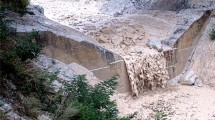Abstract
Stony debris flows are investigated at the laboratory scale. A set of 11 experiments are carried out, to simulate the stony debris flow propagation in a typical mountain confluence with a downstream water channel. The dynamic of the tributary flow just upstream of the junction with the river, surrogated through the volumetric mixture discharge, is assessed through the analysis of velocity profiles, while observations on deposit morphology provide insight into the condition which cause the blockage of the main stream. Energy dissipation within the solid–liquid mixture is mainly controlled by collisions between grains, and a dilatant fluid model is found to approximately reproduce the velocity profile. The degree of river blockage caused by the delivered material is classified according to three configurations: (i) full blockage, whereby the entire transversal river section is dammed (100% river obstruction); (ii) no blockage when less than 60% of the transversal river section is interested by the deposit; (iii) partial blockage for intermediate damming configurations (>60% and <100% of the river obstruction).
Access this chapter
Tax calculation will be finalised at checkout
Purchases are for personal use only
Similar content being viewed by others
References
Arattano M, Franzi L (2004) Analysis of different water-sediment flow processes in a mountain torrent. Nat Hazards Earth Syst Sci 4:783–791
Berti M, Genevois R, Simoni A, Tecca PR (1999) Field observations of a debris flow event in the Dolomites. Geomorphology 29:265–274
Berti M, Genevois R, LaHusen R, Simoni A, Tecca PR (2000) Debris flow monitoring in the acquabona watershed on the dolomites (Italian alps). Phys Chem Earth (B) 25(9):707–715
Dang C, Cui P, Cheng Z (2009) The formation and failure of debris flow-dams, background, key factors and model tests: case studies from China. Environ Geol 57:1901–1910. doi:10.1007/s00254-008-1479-6
Gregoretti C, Dalla Fontana G (2008) The triggering of debris flow due to channel-bed failure in some alpine headwater basins of the dolomites: analyses of critical runoff. Hydrol Process 22(13):2248–2263
Hungr O, McDougall S, Bovis M (2005) Entrainment of material by debris flows. In: Jakob M, Hungr O (eds) Debris-flow hazards and related phenomena. Springer, Berlin, pp 135–158
Iverson RM (2012) Elementary theory of bed-sediment entrainment by debris flows and avalanches. J Geophys Res 117:F03006. doi:10.1029/2011JF002189
Stancanelli LM, Lanzoni S, Foti E (2015) Propagation and deposition of stony debris flows at channel confluences. Water Resour Res 51(7):5100–5116
Takahashi T (2007) Debris flow, mechanics, prediction and countermeasures. Taylor & Francis, London, 46 p. ISBN: 978-0-415-43552-9
Acknowledgements
The authors would like to thank Enrica Belluco from the Hydraulic Laboratory of the University of Padova for help with the experimental development and Rosaria Musumeci from the Department of Civil Engineering and Architecture of the University of Catania for insightful discussions. Thanks also to prof. Carlo Gregoretti who provides us the field image of stony debris flow channel acquired in Fiames, Cortina d’Ampezzo (Italian Dolomites). This work has been partly funded by the EU funded project HYDRALAB PLUS (proposal number 654110) and—financed by MIUR within PON R&C 2007–2013 Research Project “CLARA—CLoud platform and smart underground imaging for natural Risk Assessment”.
Author information
Authors and Affiliations
Corresponding author
Editor information
Editors and Affiliations
Rights and permissions
Copyright information
© 2017 Springer International Publishing AG
About this paper
Cite this paper
Fichera, A., Stancanelli, L.M., Lanzoni, S., Foti, E. (2017). Stony Debris Flow Debouching in a River Reach: Energy Dissipative Mechanisms and Deposit Morphology. In: Mikoš, M., Casagli, N., Yin, Y., Sassa, K. (eds) Advancing Culture of Living with Landslides. WLF 2017. Springer, Cham. https://doi.org/10.1007/978-3-319-53485-5_44
Download citation
DOI: https://doi.org/10.1007/978-3-319-53485-5_44
Published:
Publisher Name: Springer, Cham
Print ISBN: 978-3-319-53484-8
Online ISBN: 978-3-319-53485-5
eBook Packages: Earth and Environmental ScienceEarth and Environmental Science (R0)



